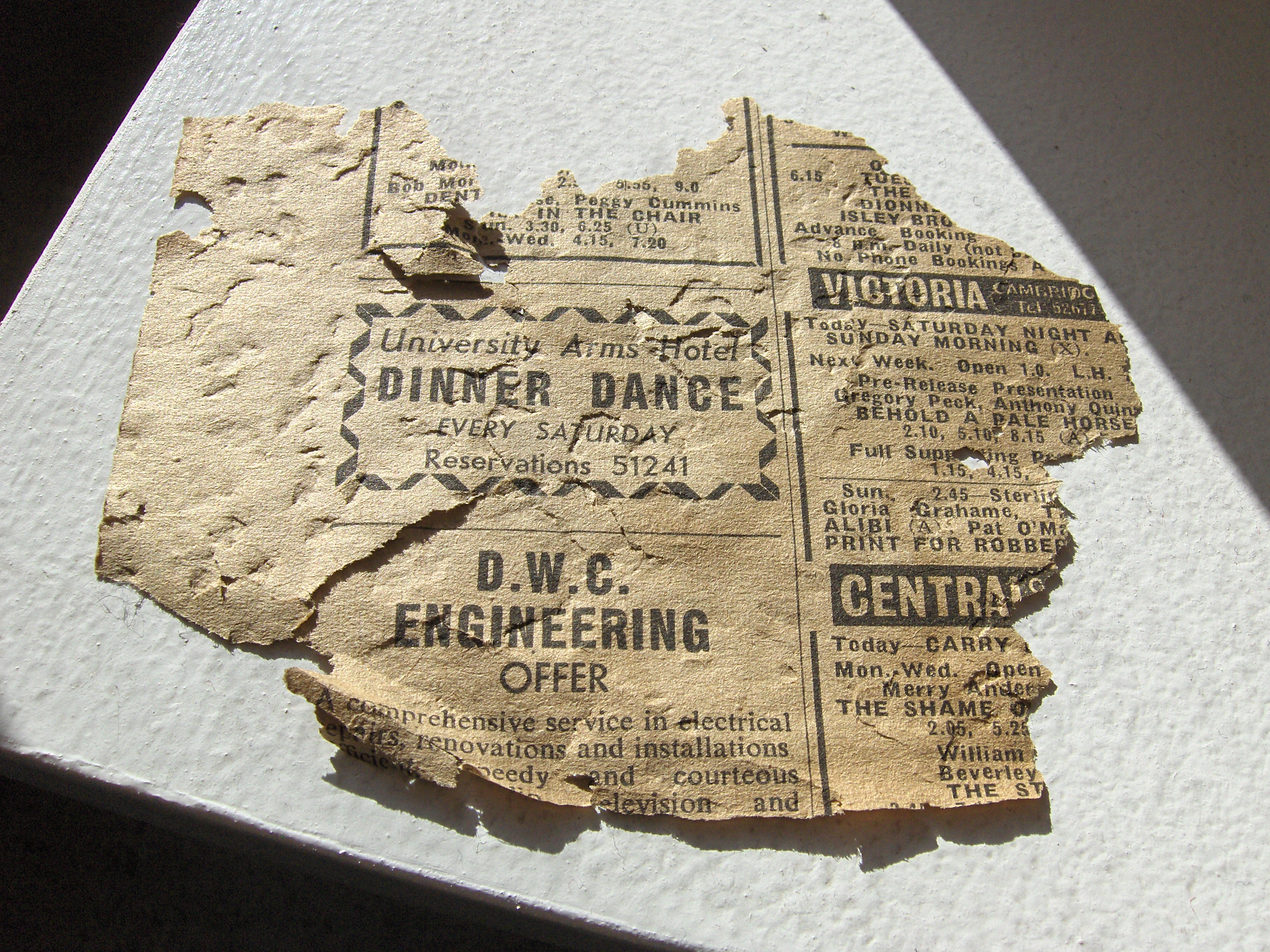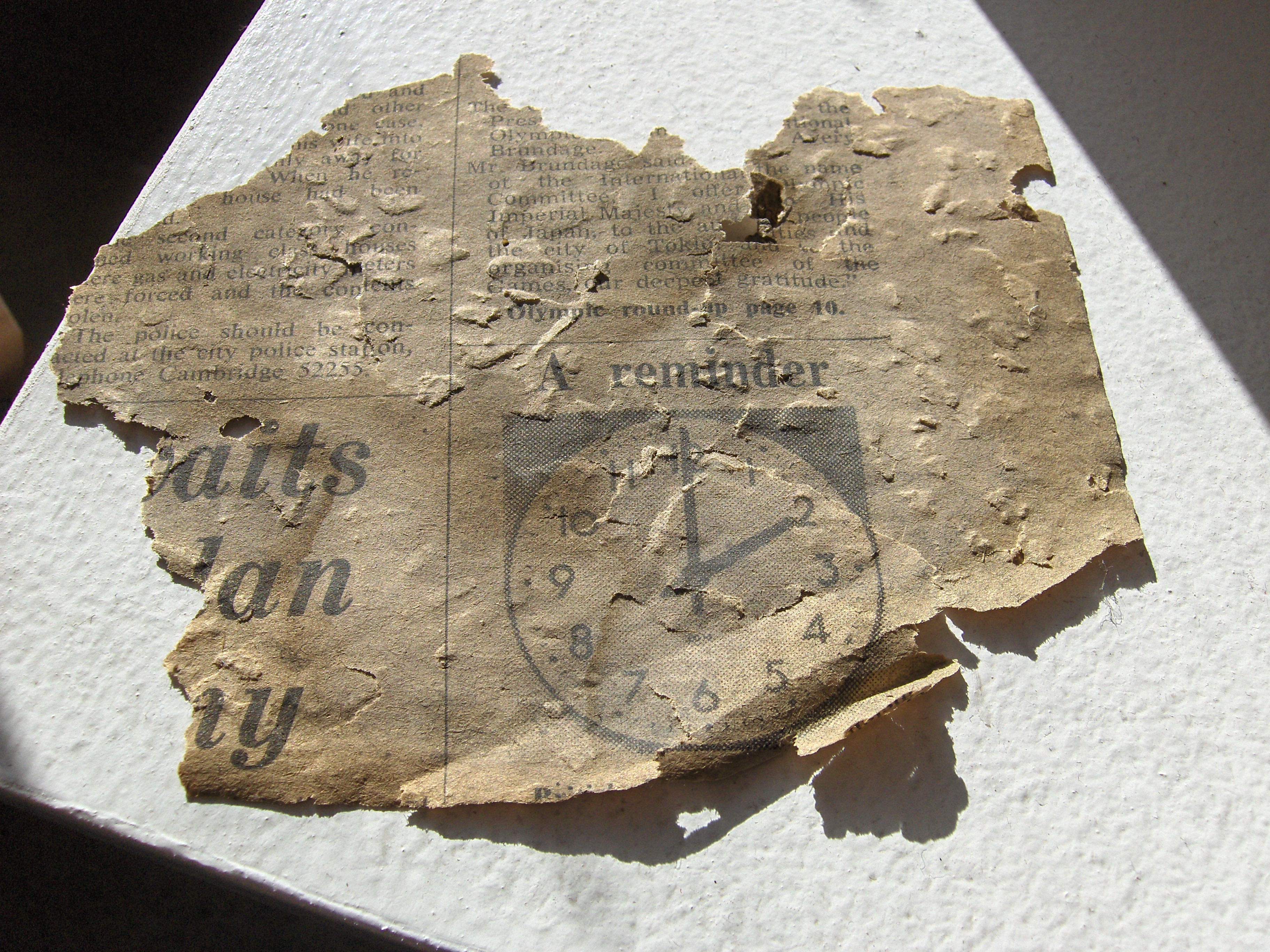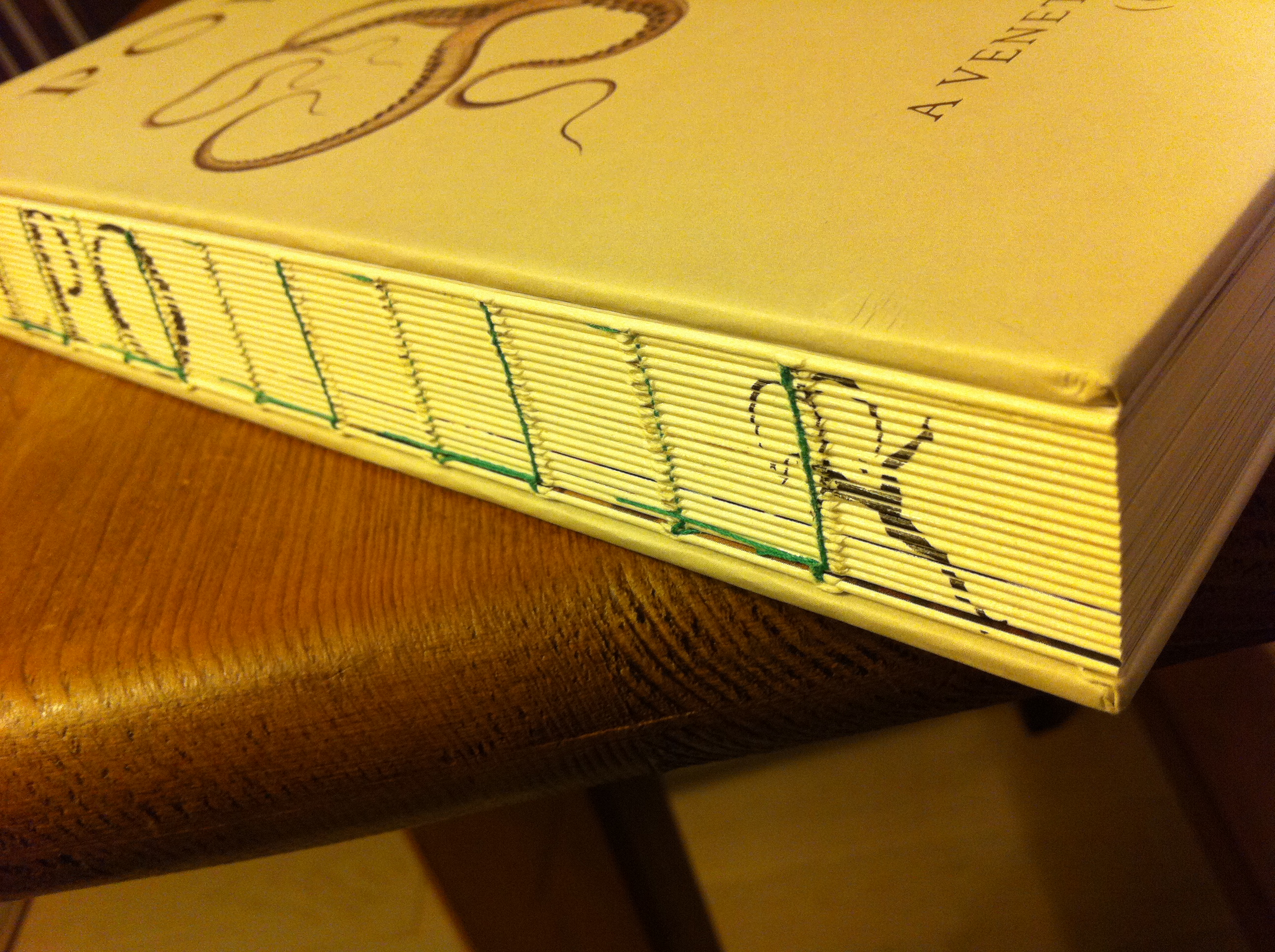 One thing that is bound to happen as e-texts threaten to displace traditional printed books is that publishers will fight back by designing ever more beautiful objects. This is the binding of a cookery book which comes without a spine–just threads running across folds of paper. Or so it appears. In fact, when you run your hand across it, it feels gluey, as though those green strings aren’t really doing much of the work. Still it’s a nice surprise and somehow appropriate to a genre which is all about remembering that you’re flesh and blood, at the end of the day and at quite a few times in the day before that.
One thing that is bound to happen as e-texts threaten to displace traditional printed books is that publishers will fight back by designing ever more beautiful objects. This is the binding of a cookery book which comes without a spine–just threads running across folds of paper. Or so it appears. In fact, when you run your hand across it, it feels gluey, as though those green strings aren’t really doing much of the work. Still it’s a nice surprise and somehow appropriate to a genre which is all about remembering that you’re flesh and blood, at the end of the day and at quite a few times in the day before that.
An international conference on collecting, editing, performing, producing, reading, and reviving Romanticism at the Fin de Siècle
Trinity College Oxford, 14-15 June 2013
Keynote Speaker: Professor Joseph Bristow (UCLA)
Call For Papers
This conference places Romanticism at the core of the British Fin de Siècle. As an anti-Victorian movement, the British Fin de Siècle is often read forwards and absorbed into a ‘long twentieth century’, in which it takes the shape of a prehistory or an embryonic form of modernism. By contrast, Fin-de-Siècle authors and critics looked back to the past in order to invent their present and imagine their future. Just at the time when the concept of ‘Victorian’ crystallized a distinct set of literary and cultural practices, the radical break with the immediate past found in Romanticism an alternative poetics and politics of the present.
The Fin de Siècle played a distinctive and crucial role in the reception of Romanticism. Romanticism emerged as a category, a dialogue of forms, a movement, a style, and a body of cultural practices. The Fin de Siècle established the texts of major authors such as Blake and Shelley, invented a Romantic canon in a wider European and comparative context, but also engaged in subversive reading practices and other forms of underground reception.
The aim of this conference is to foster a dialogue between experts of the two periods. We welcome proposals for papers on all aspects of Fin-de-Siècle Romanticism, especially with a cross-disciplinary or comparative focus. Topics might include:
bibliophilia and bibliomania – collecting – cults – editing – objects – performance – poetics – politics – print culture – sociability – continuities and discontinuities – Romanticism and Decadence – Romantic Classicism – European Romanticism and the English Fin de Siècle
Deadline for abstracts: 15 January 2013
Please email 300-word abstracts to romanticfin@bbk.ac.uk
Conference organisers: Luisa Calè (Birkbeck) and Stefano Evangelista (Oxford)
This conference is co-organised by the Birkbeck Centre for Nineteenth-Century Studies and the English Faculty of Oxford University with the support of the MHRA
The Bibliographical Society invites applications for awards from scholars engaged in bibliographical research (on, for example, book history, textual transmission, publishing, printing, bookbinding, book-ownership and book-collecting). The Society hopes to make awards both for immediate research needs, such as for microfilms or travelling expenses, and for longer-term support, for example to assist with prolonged visits to libraries and archives.
KATHARINE F. PANTZER JR RESEARCH AWARDS IN THE HISTORY OF THE PRINTED BOOK
The Society has received a generous bequest from the estate of the distinguished bibliographer Katharine F. Pantzer Jr and has established two research awards in her memory: a Fellowship of up to £4,000, and a Scholarship of up to £1,500, to be awarded annually.
Applicants’ research for either of the Pantzer awards must be within the field of the bibliographical or book-historical study of the printed book in the hand-press period, that is up to c.1830. Applicants should be established scholars in the field but may be university-based or independent researchers. The Pantzer Fellowship, worth up to £4,000, is intended to assist with both immediate research needs, such as microfilms or travelling expenses, and longer-term support, for example prolonged visits to libraries and archives. Applicants may use a part of the Fellowship money to pay for teaching cover.
MAJOR GRANTS
A number of major awards, up to a maximum of £2,000 each, are offered. Several of these take the form of named awards. One will be associated with the name of the late Barry Bloomfield, sometime president of the Society, and one or more will be associated with the Antiquarian Booksellers’ Association, which has generously contributed to the fund. The Society also offers the Katharine F. Pantzer Jr Research Scholarship of up to £1,500, the Fredson Bowers award of $1,500 funded by the Bibliographical Society of America, the Falconer Madan award of £500 in conjunction with the Oxford Bibliographical Society for research undertaken in Oxford libraries or, under certain circumstances, conducted elsewhere upon topics connected with Oxford; the holder of the Madan award may be eligible to apply for association with Wolfson College, Oxford. The named awards may be supplemented from the Society’s research funds to a maximum total of £2,000 each.
MINOR GRANTS
In addition, the Society offers a limited number of minor grants, of £50 to £200, for specific purposes such as the costs of travel or of microfilming for research purposes (but not for attendance at, or travel to, conferences). Applications for these minor grants may be submitted at any time and should be supported by one reference.
CONFERENCE SUBVENTIONS
The Society offers a number of subventions of up to £250 each to organizers of conferences so that they can help defray the cost of conference fees for at least two students. The subject of the conference must fall within one or more of the areas of interest specified in the first paragraph. Conference organizers granted a subvention must agree to mention the Society’s support in their conference literature, for which purpose a logo is provided.
Full guidelines and application forms for all grants and awards can be found at http://www.bibsoc.org.uk/grants.htm
Applications for the Pantzer Fellowship and Major Grants (including the Pantzer Scholarship ) must be submitted, on the appropriate form (http://www.bibsoc.org.uk/grants.htm); two referees familiar with the applicant’s work should be provided. Applications and references must arrive by 11 January 2013. All applications must be supplied electronically. References are preferred via email, but may also be posted, to arrive by the same date.
Applications for Minor Grants may be submitted at any time, on the form provided by the Society (http://www.bibsoc.org.uk/grants.htm). Applications must be supplied electronically. References are preferred via email, but may also be posted.
Applications for Conference Subventions may be submitted at any time, on the form provided by the Society (http://www.bibsoc.org.uk/grants.htm). Applications must be supplied electronically. Brief supporting documentation (e.g. Call for Papers, Draft Programme) should be appended.
Informal enquiries welcome to:
Ed Potten
Secretary to the Fellowships and Bursaries Sub-committee
Care of: Cambridge University Library
Rare Books Department
West Road
Cambridge
CB3 9DR
Which wit at the OED set the ‘Word of the Day’ to ‘chad’? Material texts have lain at the heart of American political ideology and national identity since the Declaration of Independence in 1776, which is on permanent, reverent display alongside the Constitution of the United States and the Bill of Rights in the Rotunda Building of the National Archives in Washington D.C. It is ironic that the outcome of the 2000 presidential election hung not on these grand constitutional documents but on tiny squares of waste paper, and whether they had dropped or were dangling or dimpled.
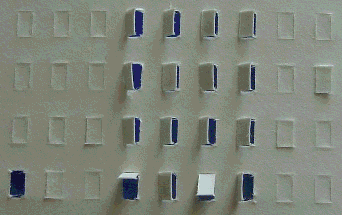
Given past and present anxieties over the reliability of the electronic voting machines that consigned the chad to the paper recycling bin of history, perhaps it is time the U.S. honoured the Founding Fathers’ commitment to the material text and reintroduced to its democratic process a piece of paper and a stubby little pencil on a piece of string.
National Trust Libraries: Mobility and Exchange in Great House Collections
November 2nd, 2012Events; Jason Scott-WarrenHosted by the Centre for Material Texts, sponsored by the Arts and Humanities Research Council (UK)
Gonville and Caius College, Cambridge
Friday 1st February 2013
This one-day event will take as its starting point the recent opening to wider research of a number of significant great house private libraries in the United Kingdom, thanks to the on-going cataloguing work being undertaken by the National Trust. Papers and discussion will treat themes including the migration of books and ideas in and out of libraries; communities of the library (how ‘private’ was a private library?); libraries as repositories of cultural history.
Attendance is free, but registration is required. Please contact Dunstan Roberts (dcdr2@cam.ac.uk) or Abigail Brundin (asb17@cam.ac.uk) for more information.
This week’s material text was destined for the rubbish bin, along with a great many dead spiders. Since moving house recently, I’ve spent too much time emptying boxes and dusting shelves, and this grimy scrap of newspaper was dislodged from somewhere during the course of my tidying. The name of the newspaper and date of publication do not appear on this fragment, but some casual investigations revealed that it is nearly half a century old, and from a local paper – the University Arms, venue for the ‘Dinner Dance’, is just around the corner from where I live. The cinema listings for a ‘pre-release presentation’ of the film Behold a Pale Horse, starring Gregory Peck, date it to 1964, and on the other side, you can just about make out the end of a report about the Olympics in Tokyo, which took place in October of that year, as well as a reminder about the seasonal changing of the clocks.
Last week I heard a lecture by Hugo Rifkind (columnist for The Times and The Spectator) in which he shared his cynical perspective on the future of newspapers. In the UK, most of the national broadsheets and tabloids are now published in both print and digital formats, and Rifkind showed some statistics which suggested how rapidly the demand for the former is decreasing. The fastest-growing newspaper format is the ‘app’ for tablet computers, which offers subscribers a convenient way to read their newspaper of choice on a portable screen while retaining some of the familiar layout of the printed version. The implications of these changes in the marketplace are manifold for newspapers and their employees. Rifkind spoke about his own growing nostalgia for the dying culture of printed news and all the rituals it incorporated – his paper, The Times, is no longer printed in the building in which he and his colleagues work, and so gone is the possibility of running down to the basement at 3 in the morning to see your column coming literally hot off the press. While news journalism will continue to evolve in many different forms, how long does the newspaper have left?
Come and see Queens’ Old Library any day this week between 12.30 and 3.30
All this week (October 22-26) Queens’ Old Library is open between 12.30 and 3.30 for visitors to have a look round the library and view our current exhibition: “The Advancement of Learning at Queens’ College in the 17th century” (http://goo.gl/XafJL).
Please enter the college via the Queens’ Lane entrance and knock on the door of the Student Library (the building on the right hand side of the courtyard as you enter). Access to the Old Library will be from the first landing on the spiral staircase in the Student Library (WML) entrance area.
Spaces of the book : materials and agents of the text/image creation (XXth and XXIst Centuries)
Trinity College, Cambridge, 6 and 7 September 2013
The conference will consider the book as a space of creation in which text and image stand in dialogue (illustrated books, livres d’artistes, artists’ books), from the point of view of its medium (materials, format, folding, etc.) and the various agents (writers, artists, as well as typographers, printers, graphic artists, publishers, gallery owners/directors, booksellers) who play an essential role in its conception and distribution.
The main issues will be:
— To what extent do the material specificities of the chosen medium influence literary and artistic innovation?
— To what extent do the various agents involved in the conception, composition, publication and distribution of the book play a role in the creative process, in contexts which also include digital media, installation and performance?
— Are there privileged sites for the distribution and reception of these works? Is the creative book an object to be called up from a rare books collection or a work to be exhibited (museums, galleries), or activated?
— How are the current transformations of both object and process modifying its social and political impact?
— Does the virtual book abolish the distinction that was traditional in the context of industrial reproduction between creative book and mass-market product?
— Does the multiplication of collective and even impersonal creations imply a new conception of creator or author?
During the conference, an exhibition on the avant-garde publisher, bookseller and gallery-owner Jean Petithory will take place in the Wren Library, Trinity College, Cambridge.
The conference languages are English and French.
Please send your proposal (maximum 500 words) before 31 January 2013 to espacesdulivre@trin.cam.ac.uk
Organisers : Isabelle Chol (Université de Pau) and Jean Khalfa (Trinity College, Cambridge).
This conference is part of the ANR-LEC programme: http://lec.hypotheses.org/presentation
Colour-Printed Book Illustrations in Tudor England, 1485-1603
October 10th, 2012Gallery; Jason Scott-WarrenElizabeth Upper, Munby Fellow in Bibliography at Cambridge University Library 2012-13
The study of the history of English colour prints is grounded on the belief that none were produced for the 250 years between the Book of St. Albans in 1486 and the explosion of publications with colour illustrations in the mid-eighteenth century. However, many Tudor woodcuts printed in colour survive; all are book illustrations that have not been systematically described as colour prints by bibliographers and are not known to art historians, and many have innovative techniques or use colour in surprising ways. These vivid borders, vignettes, printers’ devices and zodiacal men challenge long-held assumptions about the relationship between printed text and image in early English publications and the early history of colour printing in Europe.
This surprising gap in the literature has not been challenged by historians of art, literature, printing or the book; studies of English colour prints that encompass the sixteenth and seventeenth centuries either skip from the one book in 1486 to the mid-1700s or simply start with the latter. They are inconsistently recorded in histories of colour printing and bibliographical studies of early English books. The oversight is not local; there is a similar neglect of colour-printed illustrations from sixteenth-century books in countries as far-flung as France, Mexico, Portugal, Spain and Switzerland due to the lack of a standard descriptive terminology for their unusual techniques of printing, a pervasive bias against colour in the study of graphic art, and the absence of colour from many digitization projects.
Addressing these omissions, my project for the 2012/2013 Munby Fellowship in Bibliography at the Cambridge University Library will result in the first study of sixteenth-century English colour prints. It will demonstrate that not only were colour prints produced in Tudor England, but also that their numbers and techniques are in keeping with previously unrecognized European trends uncovered by my dissertation research.
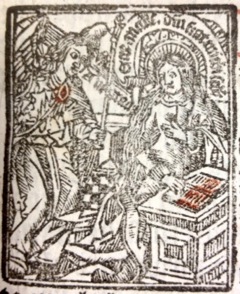
The Annunciation, colour woodcut from two impressions (black and red), in The Primer in Latin and Englishe [1555]. CUL, Young 263, fol. A1r. With the permission of the Syndics of the Cambridge University Library.
The anticipated findings about early, vivid and visual paratexts and the widespread dissemination of colour printing techniques in the sixteenth century should be relevant to fields including bibliography, the history of the book, the history of art and the study of material texts. As this project demonstrates that Tudor colour woodcuts are important expressions of international trends in the first centuries of colour printing, its immediate impact should be the enabling of further bibliographical research about early English colour printing, especially in Cambridge collections. In the longer term, it should contribute to the reassessment of the role and reception of colour in printmaking in early modern Europe.
I was interested to read in my weekend newspaper that when Michael Gove, secretary of state for education in the UK’s current coalition government, decreed that every school in the land must have a leather-bound copy of the King James Bible, the copies were inscribed ‘Presented by the Secretary of State for Education’. Scouring the web, I find that in fact these words were not just ‘inscribed’ in the books, they were actually tooled onto the bindings.
Does this kind of thing go on everywhere, or just here? I’d be very interested to learn whether followers of this blog know of other acts of large-scale book-giving by authorities around the world, especially if they have pictures of the curious books that result.
